
What are fossils? What are they used for? How are they formed? Types, examples, names. How to differentiate a dinosaur from other giant animals?
A reader of the portal delamazonas.com asks us if dinosaur fossils have been found in the Amazon basin, and if so, when they existed and when they became extinct.
From that super-interesting question springs more and more questions.
- How was the Amazon formed?
- Were there dinosaurs in the Amazon?
- What other giant animals lived in the Amazon?
But in order to answer these questions correctly, it is first necessary to know some basic concepts…
What are fossils and what are they used for?
Fossils are like an open book that tell the history of the Earth for a paleontologist.
They tell him a story that only he can read with some certainty or, rather, with some approximation.
They talk about ancient life forms and possible ecosystems that existed.
The word “paleontology,” the profession of paleontologists, consists of three Greek words: palaios, ancient; ontos, being, or that which is; and logos, treatise or foundation.
The paleontologist reads the remains, footprints or casts of living beings that have not existed for more than 10,000 years, which is the minimum period to be considered a “fossil.”
How are fossils formed?
Fossils are organic substances that have been petrified by chemical and geological processes and are preserved within a rock, usually a sedimentary rock.
There are 4 main ways in which fossils are formed:
- By sedimentation: when the sediments enclose the bodies, preserving their most resistant part: their exoskeleton.
- By casting: molds printed on negatives of the organisms,
- By mineralization: a material preserved by water.
- Carbonization: oxygen and hydrogen are lost from the bodies, but not the carbon layer, which preserves the footprint of the organisms.

Author:CARLOS TEIXIDOR CADENAS / CC BY-SA
Examples of famous fossils
Among fossils, there are some that stand out more than others and have become famous, such as those mentioned below:
- Fossils of aquatic plants:
- Montsecchia vidalii (the oldest flowering plant fossil found in Spain, dated at 130 million years old).
- Archaefructus sinensis (China, 125 million years old),
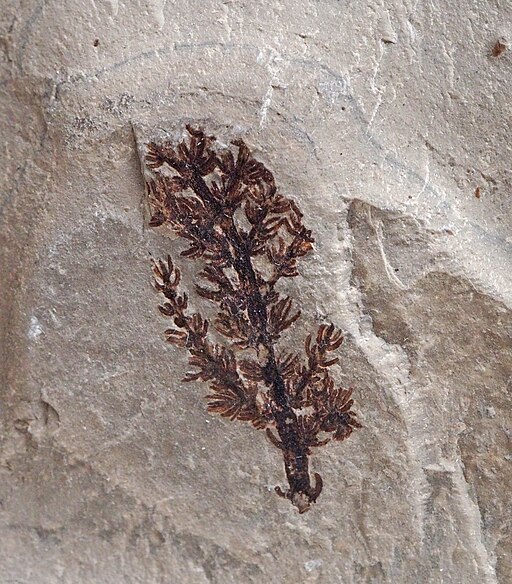
- Fossils of small mammals:
- Ragonon eurasiaticus (17 cm long and weighing 80 g, found in China, and which lived 160 million years ago).
- Fossils of human beings:
- Australopithecus afarensis (known as Lucy, found in Afar, Ethiopia, 3.2 million years old),
- Homo ergaster (known as the Turkana child, who lived 1.6 million years ago)
- Homo heidelbergensis (found in Atapuerca, Spain, about 400,000 years old).
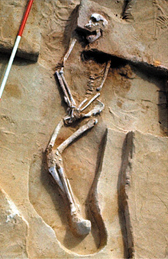
Author: James Maurice Bowler / CC BY-SA
Dinosaur fossils
- Fossils of dinosaurs that have shocked specialists include:
- Tyrannosaurus Rex, a carnivorous dinosaur from 67/65 million years ago, found in the United States.
- The Patagotitan majorum, the largest, about 40 m long and weighing 80 t, found in Chubut, Argentina, lived 10 million years ago.
- Diplodocus, found in North America, a giant dinosaur, which lived 155 million years ago.
- The best preserved among the dinosaurs found: Borealopelta markmitchelli, an armored herbivorous dinosaur, unearthed in Alberta, Canada, which lived about 110 million years ago.

Dinosaurs, yes, but what are dinosaurs?
Dinosaurs are among the largest animals that have existed on Earth, but not all large animals are dinosaurs (See: Giant animals of the Cenozoic Era in the Amazon).
A dinosaur is a “terrible lizard,” a large terrestrial diapsid animal that lived during the Mesozoic Era, between 255 and 65 million years ago.
But…
What is a diapsid animal?
Large animals differ from each other in several characteristics. One is their behavior in the habitat. But the most important characteristic is the anatomical structure of the skull, especially the existence or lack of the temporal fossae.
The temporal fossae are hollow areas, holes or recesses in the skull located behind the eye sockets. These hollow areas make the skull lighter and allow the insertion of muscles that move the lower jaw.
Depending on these temporal pits, three types of skulls are distinguished: anapsids (without temporal pits, such as turtles), synapsids (with one temporal pit, such as mammals) and diapsids (with two temporal pits, such as reptiles and birds). The dinosaur was a large diapsid animal.
Not every large animal is a dinosaur
The dimetron, with a definite reptilian appearance, is called a dinosaur without actually being one. It is a therapsid with a synapsid skull, and which populated the Earth in the Paleozoic Era, between 300 and 270 million years ago, at a time before the dinosaurs.
What are the 2 main groups of dinosaurs?
Dinosaurs belong to the superorder Dinosaurea, which is divided into two groups or orders: Ornithischia and Saurischia.
Ornithischia
The order Ornithischia corresponds to dinosaurs with “bird hips,” in which the hip bones (pubis or ischium) are oriented backwards, like Triceratops or Parasaurolphus. They are generally herbivorous dinosaurs.
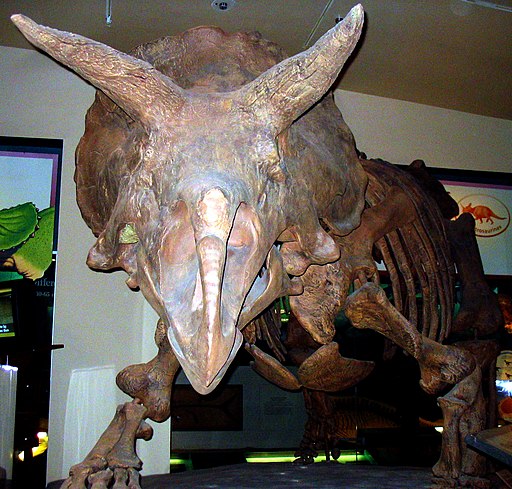
Saurischia
The order Saurischia is the “reptile-hipped” order of dinosaurs with differently-oriented hip bones. In this order there are two groups: sauropods (herbivores with large wingspans and long necks equivalent to about one third of their entire body) and theropods (bipedal carnivores).
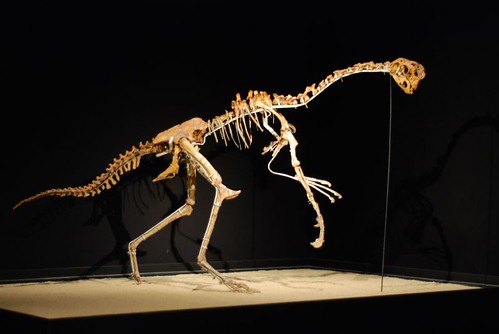
Difference between true and modified diapsids or… How to differentiate a dinosaur?
We already know that dinosaurs are large terrestrial diapsid animals (with two temporal pits), but this group also includes reptiles and birds.
Among the reptiles there were several species of extinct prehistoric animals: terrestrial reptiles (dinosaurs), aquatic reptiles (ichthyosaurs and plesiosaurs) and aerial reptiles (pterosaurs).
They were differentiated by the configuration of their skeleton, especially their skull (with two temporal pits) and by the ecosystem they inhabited and their feeding habits.
These prehistoric diapsid reptiles lived about 190 million years ago. A long period in which they evolved in their structure.
Some remained diapsids all this time.
Others lost a temporal fossa, becoming synapsids: ichthyosaurs and plesiosaurs.
Others lost their two temporal pits: the pterosaurs.
The only prehistoric animals that retained their two temporal pits were the dinosaurs.
For this reason they are called “true diapsids,” while the other two groups are known as “modified diapsids.”
So, in short, the dinosaur was a large terrestrial reptile, exclusively terrestrial.
There are no aquatic or aerial dinosaurs.
Another difference with other reptiles is that their limbs were perpendicular to the ground, so they could move in a straight line with great ease. The other reptiles had their limbs arranged in a Z-shape.
Related articles:
April 10, 2020
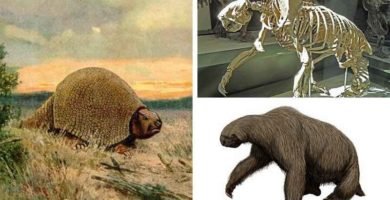
Giant animals of the Cenozoic Era in the Amazon Rainforest
April 8, 2020
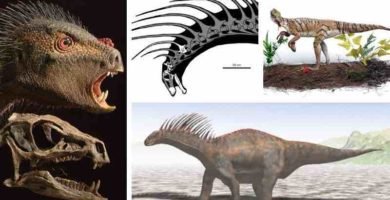
Dinosaurs in the Amazon Rainforest
April 7, 2020
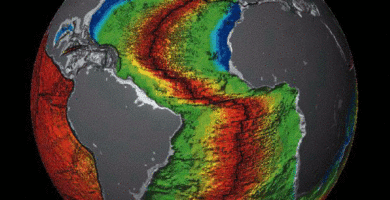
Brief history of the Amazon Rainforest landscape

Dr. Rafael Cartay is a Venezuelan economist, historian, and writer best known for his extensive work in gastronomy, and has received the National Nutrition Award, Gourmand World Cookbook Award, Best Kitchen Dictionary, and The Great Gold Fork. He began his research on the Amazon in 2014 and lived in Iquitos during 2015, where he wrote The Peruvian Amazon Table (2016), the Dictionary of Food and Cuisine of the Amazon Basin (2020), and the online portal delAmazonas.com, of which he is co-founder and main writer. Books by Rafael Cartay can be found on Amazon.com
This post is also available in:
![]() Español (Spanish)
Español (Spanish)
